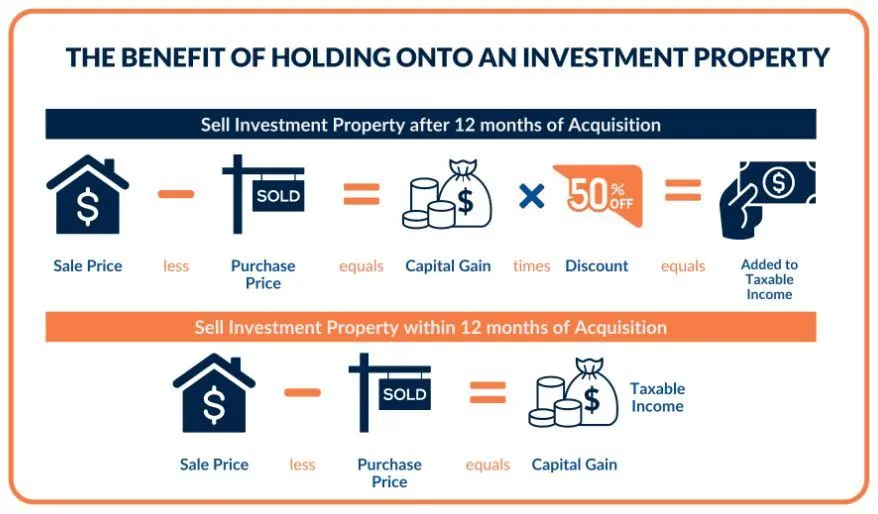
Capital Gains Tax (CGT) Guide for Property Investors
Capital Gains Tax (CGT) Guide for Property Investors
As a property investor, understanding Capital Gains Tax (CGT) is crucial to maximising your profits and minimising tax liabilities. If you plan to sell your investment property, CGT may apply. However, there are various exemptions and concessions available that can help you reduce your tax burden.
In this guide, we’ll cover everything you need to know about CGT, including how it’s calculated, when it applies, and strategies to minimise your tax liability.
What is Capital Gains Tax (CGT)?
According to the Australian Taxation Office (ATO), any profit made from the sale of an investment property is considered a capital gain and must be reported on your income tax return. Since CGT is not a separate tax but forms part of your taxable income, the amount payable depends on your marginal tax rate.
When Does CGT Apply?
CGT applies when you sell an investment property, land, holiday homes, or any other real estate asset that is not your primary residence. Even if you use the sale proceeds to pay off an outstanding mortgage, you are still required to pay CGT.
How to Minimise Capital Gains Tax on Investment Properties
The ATO provides several exemptions and concessions that property investors can use to reduce or eliminate CGT liability. These include:
1. The Main Residence (MR) Exemption
If a property is your primary residence, you may be exempt from paying CGT upon its sale. To qualify, you must have lived in the property and demonstrated residency through:
Keeping your possessions there
Updating your address on your driver’s licence and electoral roll
Using the property as your main postal address
If you rented out the property before moving in, a partial CGT exemption may apply.
2. The 6-Year Absence Rule
This rule allows you to rent out your primary residence for up to six years while still qualifying for CGT exemption. If you move back in before the six-year period expires, the exemption can be extended for another six years.
3. The 6-Month Overlap Rule
If you purchase a new home before selling your old one, you can hold both properties as your main residence for up to six months, helping you avoid CGT on the old property.
4. The 50% CGT Discount
If you have owned your investment property for more than 12 months before selling, you may qualify for a 50% discount on your CGT liability.
How is Capital Gains Tax Calculated?
CGT is calculated using one of the following methods:
1. The CGT Discount Method (For properties held for 12+ months)
Formula: Sale Price - Cost Base = Capital Gain x 50% = Taxable Capital Gain
Example: If your capital gain is $72,000 and you’ve owned the property for four years, applying the 50% discount means you only pay tax on $36,000.
2. The Indexation Method (For properties purchased before 21 September 1999)
This method adjusts your cost base for inflation using the Consumer Price Index (CPI), reducing your taxable gain.
3. Cost Base Adjustments
To further reduce CGT, add eligible expenses to your cost base, including:
Stamp duty
Legal fees
Renovation costs
Real estate agent commissions
Other CGT Considerations
1. Capital Losses
If you sell a property at a loss, you can use that loss to offset other capital gains and reduce your tax liability.
2. Property Ownership Structure
If a property is co-owned, CGT is divided based on ownership percentage. If one owner has little to no taxable income, their CGT liability may be lower.
3. Property Transfers
Even if a property is transferred to a relative, the market value at the time of transfer is still used for CGT calculations.
4. CGT on Overseas Properties
If you own property overseas, Australian CGT laws still apply. However, residency status and tax treaties may impact your liability.
Key Takeaways
If you're planning to sell an investment property, understanding CGT can help you minimise your tax liability. To maximise your investment returns:
Take advantage of CGT exemptions and concessions
Add all eligible costs to your cost base to reduce taxable gains
Consult with a property tax specialist for expert advice
At Sydney Tax & Accountancy Services, we specialise in helping property investors reduce their CGT liability and optimise tax strategies. Contact us today for expert guidance on property tax planning!
FAQs
What Are Capital Losses?
Capital losses occur when you sell a property for less than its cost base. These losses can be used to offset capital gains in the same financial year or carried forward to offset future gains.
Do You Pay Tax on Capital Losses?
No, but capital losses can reduce your taxable capital gains, lowering your CGT liability.
How is CGT Applied to Jointly Owned Properties?
CGT is split based on ownership share. If one owner has no other taxable income, their CGT liability may be lower.
What is My Income Tax Rate?
CGT is taxed at your marginal income tax rate. The ATO’s online tax calculator can help estimate your tax rate.
For personalised CGT strategies and expert property tax advice, get in touch with Sydney Tax & Accountancy Services today! 🚀
